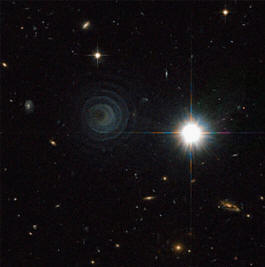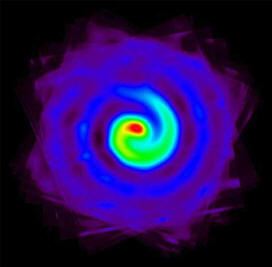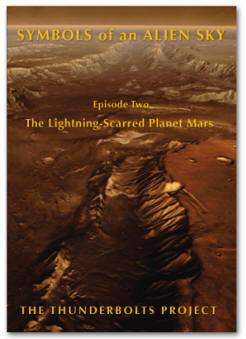|
 
IRAS 23166+1655 (left) and WR 104
(right). Credit: (left) ESA/NASA &
R. Sahai;
(right) U.C. Berkeley Space Sciences
Laboratory/W.M. Keck Observatory
Unwinding the Spirals
Apr
12, 2011
Rather than gas and dust flung
out by two stars in pirouette, these
structures reveal the characteristic
hourglass formation of a z-pinch.
Helical structures abound in the
Universe. Galaxies, planetary
nebulae, hurricanes: all exhibit
characteristic shapes that have been
identified in past
Picture of the Day
articles as
electrically induced
formations.
The term "planetary nebula" was
first applied in the early days of
telescopic observation, since they
appeared to be round, with a faint
greenish tinge, similar to the
planet Uranus, so it was assumed
that they might also be gas giant
planets.
Planetary nebulae are observed to
come in all shapes and sizes: round,
elliptical, nested cylinders, and
now helical spirals. Such features
are said to be the result of shock
waves, or stellar winds blowing off
the parent star, crashing into the
slower material ahead of them.
Consensus astronomy sees
planetary nebulae as the final stage
of senescent stars when they drive
off their outer atmospheric layers
because of increased internal
radiation pressure. It has been
suggested that stars like our Sun,
middleweights in the galactic
stable, do not undergo supernova
eruptions as they end their lives—no
explosive demise in a blaze of
glory. Instead, their gaseous
envelopes drift away into space.
According to a recent
press release, IRAS
23166+1655 is an example of that
process, except that it comprises a
binary system, so the fumes of gas
and dust are being gravitationally
drawn toward a companion star in an
800 year orbit. As stated, the
spinning pair thus create a glowing
spiral of stellar material as they
dance around one another.
WR 104, on the other hand, is a
Wolf-Rayet (WR) star, named for
astronomers Charles Wolf and Georges
Rayet. WR type stars are thought to
be three times the diameter and 25
times more massive than the Sun,
with a luminosity over 100,000 times
greater. The intense radiative
output of WR 104 is theorized to
blow off its outer layers through
"photon pressure." This so-called
"stellar wind" flying off the
rapidly rotating star is what the
Keck telescope image is thought to
represent.
As has been discussed in
past articles, almost 70
years ago
Dr. Charles Bruce noted
that planetary nebulae appeared to
be similar to electric discharges.
Rather than spheres, he reasoned
that their shapes were hourglasses,
with a central star obscured by a
dusty torus, since nebular shapes
are similar to the twisted filaments
and spirals of electric discharges
in plasma.
Electric discharges in a cloud of
plasma form
double layers along their
current axes. Positive charges build
up on one side of the cloud and
negative charges on the other. A
powerful electric field develops
between them. If enough current is
applied to the double layer it glows
otherwise, it remains in "dark mode"
and will be invisible. Electric
currents flow along the double
layers. In plasma, the currents
spiral into filaments, which attract
each other. However, instead of
merging they wind around, sometimes
"pinching down" into arc mode
discharges. If enough current passes
through the plasma cloud, a z-pinch
in the double layer will initiate
the formation of a star.
Electric double layers can be
"pumped" with energy from galactic
Birkeland currents in which they are
immersed. The excess input power
pushes them into "glow mode," while
increased flux density draws matter
from the surrounding space into
filaments, igniting the nebular
"gases" electrically
Could this be what is observed in
both examples shown above? That
question might never be answered
experimentally, because the only way
to detect double layers in space is
to send spacecraft equipped with
Langmuir probes through
them. However, more local
experiments within the Solar System
have found double layers like those
created in the laboratory. Such
structures are known as
magnetospheres, magnetotails,
cometary nuclei, and comet tails.
Nobel laureate
Hannes Alfvén wrote:
"...it is unpleasant to base
far-reaching conclusions on the
existence of a structure which we
cannot detect directly. But the
alternative is to draw far-reaching
conclusions from the assumption that
in distant regions, the plasmas have
properties which are drastically
different from what they are in our
own neighborhood. This is obviously
far more unpleasant ..."
Stephen Smith
 New
DVD New
DVD
The Lightning-Scarred
Planet Mars
A video documentary that could
change everything you thought you
knew about ancient times and
symbols. In this second episode of
Symbols of an Alien Sky, David
Talbott takes the viewer on an
odyssey across the surface of Mars.
Exploring feature after feature of
the planet, he finds that only
electric arcs could produce the
observed patterns. The high
resolution images reveal massive
channels and gouges, great mounds,
and crater chains, none finding an
explanation in traditional geology,
but all matching the scars from
electric discharge experiments in
the laboratory. (Approximately 85
minutes)
Video Selections
Order Link
|






 New
DVD
New
DVD

